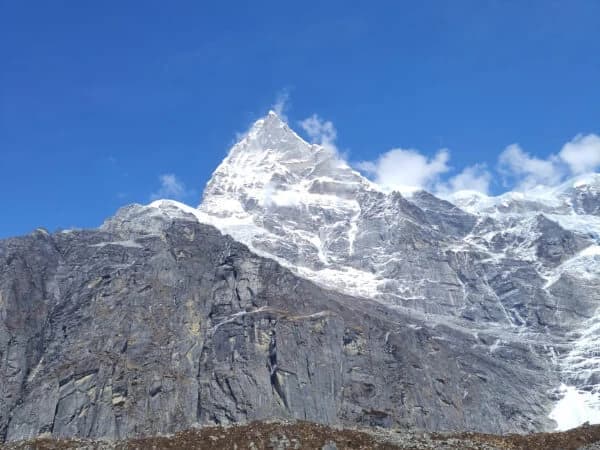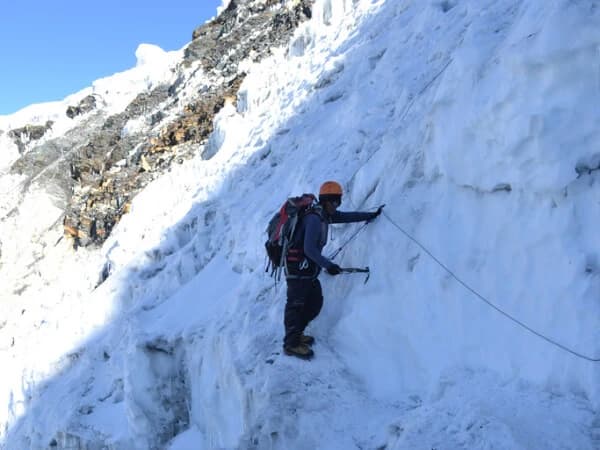Accommodation during Lobuche Peak Climbing
During your Lobuche Peak Climbing expedition, you will have various accommodation options including mountain lodges, tea houses, and tented camps. In the villages along the route, you’ll find lodges with basic amenities. However, at the base camp and high camp, you will be camping in tents.
Rooms in lodges are typically twin-sharing, which helps to keep costs down. If you prefer a single room, be aware that it may come at a higher price. Most lodges have shared washroom facilities. From Lobuche Base Camp onward, you will spend your nights in tents. Our team provides all necessary camping equipment, including single-branded sleeping tents for each team member and shared dining and toilet tents.
For those seeking more comfort, we can help arrange stays in high-end hotels and tea houses that fit your budget. Throughout the Lobuche Peak ascent, you can find luxury and premium lodges as well as budget-friendly options. These accommodations offer comfortable mattresses, electric blankets, hot and cold showers, free Wi-Fi, and other amenities. While the rooms are generally small, they are cozy and typically shared by two people.
Meals during the Lobuche Peak Climbing
We provide three meals a day throughout your journey. In the villages, meals are served according to the lodge menu, offering a variety of dishes. As you ascend and the altitude increases, the menu choices become more limited. When camping, our crew will prepare your meals. Drinking water is widely available; we recommend carrying a reusable water bottle and water purification tablets for added safety.
Climbing at high altitudes requires significant energy, so it is important to consume a diet rich in carbohydrates and proteins. Local foods and delicacies are usually more hygienic and nutritious. Avoid frozen snacks that may take days to reach the trails.
A balanced Nepali meal like Dal Bhat, which includes lentils, beans, and pulses, is ideal. Traditional Sherpa soup, known as Syakpa, is also nutrient-rich. Seasonal vegetables served in the tea houses will provide necessary nutrients. High-fiber cereals such as buckwheat, millet, and barley are also highly nutritious. You can also enjoy a variety of dishes like noodles, spaghetti, macaroni, pizza, lasagna, curry, and fried rice.
Travel Insurance
We strongly recommend obtaining travel insurance before engaging in any adventurous activities, including peak climbing in Nepal. Given the inherent risks, it’s crucial to have insurance that covers unexpected events. Ensure your policy includes helicopter evacuation and hospitalization, as helicopter rescue is the primary means of emergency evacuation in case of weather or medical emergencies. Confirm with your insurance provider that peak climbing in Nepal is covered under your policy.
By planning ahead and making the necessary preparations, your Lobuche Peak climbing experience can be both safe and enjoyable.
Best Seasons for Lobuche Peak Climbing
Timing is crucial for a successful Lobuche Peak expedition The optimal times to climb are during the Spring (March to May) and Autumn (September to November) seasons. These periods offer ideal trekking and climbing conditions, with stable weather, clear skies, and warm temperatures. Both seasons are typically free of rain, reducing the chances of having to postpone the climb.
Climbing during Spring or Autumn allows you to fully enjoy the expedition. Clear skies mean you can carefully watch every step, and you'll be rewarded with stunning panoramic views of the Everest region’s peaks. The absence of clouds ensures unobstructed vistas, making the experience even more memorable. Choosing these seasons for your climb ensures a safer and more enjoyable adventure.
The Challenges and Best Time for Lobuche Peak Climbing
Challenges of Lobuche Peak Climbing
Lobuche Peak is considered one of the more challenging trekking peaks in Nepal. This expedition involves not only steep and high-altitude trekking but also a demanding climb. Before you even begin the climb, you must trek from Lukla to Lobuche Base Camp, which requires an average of 5 to 6 hours of trekking per day over uneven, often steep and tiring trails. This can be particularly challenging for beginners who have not trekked before, as the higher altitudes of the Khumbu region can also pose a risk of altitude sickness.
Once you pass Lobuche village, the trail becomes increasingly rough, steady, and rocky. From this point, you will spend several nights camping in tents and eating food prepared by the helpers, which can be a new and potentially difficult experience for novice climbers. The trek to Lobuche Base Camp is marked by steeper and more rugged terrain, sometimes requiring the use of mountaineering gear such as ropes and ice axes.
On the summit day, you will face a demanding climb to reach Lobuche East and then return to the base camp, a journey that typically takes about 8 to 10 hours. The summit climb itself includes a particularly challenging section: a steep, snowy slope with a 45° angle that stretches for about 50 meters. This part of the climb can be especially tough for beginners, testing their skills and endurance.
Despite these challenges, Lobuche Peak is a feasible objective for those with prior mountaineering training, practice, and knowledge. While it may be difficult, it is a rewarding experience for those prepared for the adventure.
Lobuche Peak Climb: Seasonal Insights
Climbing Lobuche Peak in September
September marks the beginning of autumn in Nepal, arriving a bit earlier in the Himalayas. Early in the month, the trails are less crowded, offering a more serene experience. However, as the month progresses, the number of climbers increases, drawn by the favorable weather.
Temperatures during this period range from 0 to 15 degrees Celsius, with chilly nights. The days, however, are bright and sunny, providing clear views of Ama Dablam and Makalu. Early September can still experience some rain, so climbers should be prepared for wet conditions and exercise caution.
Climbing Lobuche Peak in October
October is the most popular month for climbing Lobuche Peak. The weather is typically stable, making the ascent more manageable. The autumn foliage adds a vibrant splash of color to the trails, with leaves turning brilliant shades of orange and scarlet.
The trails become busier with trekkers, and teahouses are lively with visitors. Wildlife such as musk deer and Himalayan Tahr may be spotted along the way. Despite the increased foot traffic, October’s favorable conditions make for an enjoyable climb.
Climbing Lobuche Peak in November
November marks the transition from autumn to winter. While the weather remains generally clear and sunny, temperatures begin to drop, especially at higher altitudes. Early in the month, climbers can still enjoy pleasant conditions, but as the weeks go by, it gets colder.
Snowfall is not yet significant, but the potential for winter weather increases towards the end of the month. Daytime temperatures can reach up to 12 degrees Celsius, but it gets much colder after sunset, with temperatures at the peak dropping below -10 degrees Celsius. Proper layering and warm gear are essential for this period.
Climbing Lobuche Peak During Spring (March, April, and May)
Spring is another excellent season for climbing Lobuche Peak. The weather gradually improves, making it an ideal time for trekking and climbing. The slopes are adorned with blooming rhododendrons, adding a touch of beauty to the challenging terrain.
Climbing Lobuche Peak in March
March offers a beautiful landscape with post-winter tranquility. The early weeks are colder, but by the end of the month, temperatures become more stable, reaching up to 17 degrees Celsius during the day. Nights remain cold, with temperatures ranging from -7 to -14 degrees Celsius. Snowstorms can occur, so climbers should be prepared.
Climbing Lobuche Peak in April
April brings warmer days and steadily rising temperatures, making it a delightful month for climbing. Daytime temperatures typically vary between 0 and 15 degrees Celsius.The trails become busier as the month progresses, but the clear, sunny weather provides excellent climbing conditions. The lingering effects of winter are mostly gone by now.
Climbing Lobuche Peak in May
May sees temperatures rising further, with daytime highs reaching 15 degrees Celsius or more. Although it’s warmer at lower elevations, temperatures at the summit remain below 0 degrees Celsius. The onset of summer brings increasingly warm days, though climbers should not expect full summer conditions. The trails can become crowded, but the weather remains generally favorable.
Climbing Lobuche Peak During Monsoon (June-August) and Winter (December-February)
Monsoon Season (June-August)
The monsoon season is characterized by heavy rainfall, which turns the trails muddy and slippery. Wild leeches are common during this period. Despite these challenges, climbing Lobuche Peak is still possible with the right preparation and additional gear to ensure safety on the wet terrain.
Winter Season (December-February)
Winter presents its own set of challenges, including freezing temperatures, heavy snowfall, and icy trails. Extra warm clothing is essential, and the deep snow can make the ascent more difficult. The weather can be harsh and unpredictable, requiring climbers to be well-prepared for extreme conditions.
By choosing the right season and preparing adequately, climbers can enjoy a rewarding and memorable experience on Lobuche Peak. Whether in the vibrant autumn or the blossoming spring, each season offers unique challenges and breathtaking beauty.
Recommended Peaks to climb in Khumbu (Everest Region)
If you are interested in other climbing adventures, you may also like:
Lobuche Peak Climbing
Mera Peak Climbing
Island Peak Climbing
Prepare yourself well, choose the right season, and embark on an unforgettable journey to Lobuche Peak.
Required Gear for the Lobuche Peak Ascent
Handwear
- nsulated Gloves
- Hand Warmers
Footwear
- Trekking Boots
- Altitude Liners
- Woolen Socks
- Trekking Socks
- Sandals
Headwear
- Hiking Caps
- Woolen Hats
- Scarves
Upper Body Clothing
- Down Jacket
- Fleece Jacket
- Thermal Underwear
- Hiking T-Shirts
- Windproof and Waterproof Jackets
Lower Body Clothing
- Down Pants
- Trousers
- Thermal Sets
- Hiking Pants/Shorts
Personal Equipment
- Trekking Backpack
- Toiletry Bag
- Sunblock Lotion
Trekking Gear
Climbing Gear
- Ice Axe
- Climbing Harness
- Crampons
- Carabiners
- Belay Device
- Ascender
Additional Mountaineering Gear
- Mountaineering Boots
- Helmet
- Ropes
- Ice Screws
Having the proper gear is crucial for a safe and successful climb. Ensure you have all these items to be well-prepared for your Lobuche Peak expedition.









